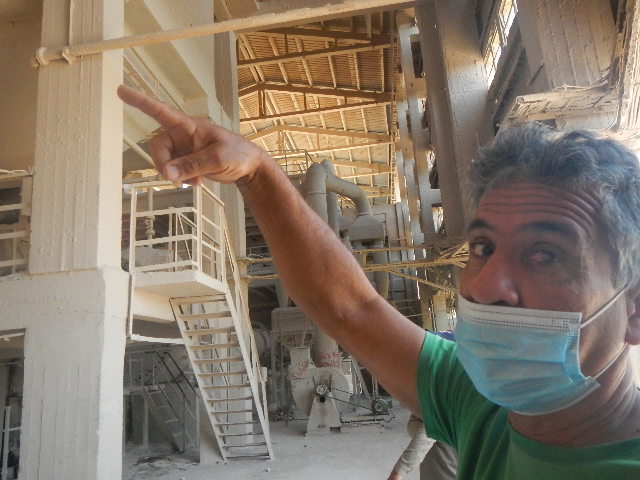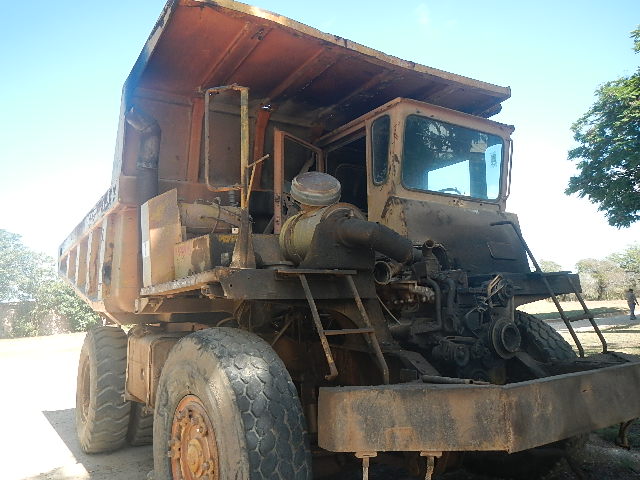Niorgen Buchillón García, loader operator, a 24-carat man
He leaves his house with the irresolute idea of not knowing when he will return, as happened with one of the last trains he loaded. It began at nine at night and ended after twelve, "so that he would not be late."
Niorgen Buchillón García, cargo operator, a 24-carat man, repeats the phrase with the simplicity of the skin —and lips—. "Yes, so that he wouldn't be late."
You usually see the same thing down there, in the mine, as up here where they load the crushed gypsum destined for various cement factories in the country.
«The thing about that train was terrible. Loading at that time is not repeated much in times of scarcity, but imagine how many times I have been forced to do it over the years, if I started my working life as a gruero in the quarry almost when I was a child».
Clearly, since he was a child he decided that his thing was not to go around with his books under his arm, or on top of a boat, fishing for pejes, bad nights, storms, mosquitoes..., because the lack of fuel and the Yankee blockade hit the same in the land than in the sea.
«I decided to make a living here, in the quarry. I walked the same paths as my grandfather, Arnaldo Buchillón, and my father, Mario. Wow, many years ago. They were also bulldozers, crane and loader operators, like me. I learned a little from all of them.
«Imagine, one of those hoppers that the train brings carries 11 buckets from the loader and the train brings 13 hoppers. It means that I fill them with 123 cubes, neither more nor less, which is like taking 246 round trips to the train. Moreover, beforehand, there at the mine, I had to load the trucks that transport the raw material for the mill. One ends up with buzzing in the head».
Viamonte dreams of a modernization of the calcined gypsum plant, with the return of the three work shifts; it sounds with electricians, hose reels… Dream
This is how he tells it, more than with trauma, pain and buzz, with the honor of not giving up in the face of difficulties, which are not few in the mine, in the hammer, in the factories, because in Punta Alegre there are two factories: the plaster crushed used in the elaboration of cement, and that of set, cooked or calcined plaster, used in other purposes such as the interior divisions of houses and hotels, to manufacture the chalk used in the educational sector and for the Health branch; although in the latter, the production chains have not been very good and there is much still to be gained in terms of clientele and the quality of the finished product.
THE MINE, THE SEA, THE WEATHER AND THE GUSTS OF THE HURRICANE
If it continued down the path of deterioration, carelessness, cornered by the saltpeter of the sea that "eats" the iron and, further here, "impassive" before the gusts of Hurricane Irma, which took away roofs, walls and even an engine — they say—, the Punta Alegre mine, the largest in Latin America, would be writing the chronicle of its foretold death.
Shortly after the siege of the cyclone, in one of the visits to the place, Army Corps General Joaquín Quintas Solá, who led systematic tours to check the recovery, on more than one occasion referred that the productive enclave needed "better conditions to supply the crushed plaster required in most of the Cuban cement factories, plus the cooked plaster, used in Health, in interior constructions and the branch of medicine». Needing better conditions was a direct criticism, because the plant did not show its best image, contrary to what it shows today, although it can still be improved.
A Cuban flag and another of July 26 welcome. The lady at the entrance asks and orders them to get out of the car and use the chlorinated solutions. From there you can see the zinc plates in a part of the ceiling in the plaster plant; the other, they would tell me later, it is not necessary to roof it because it is not in use.
It's true, it took the roofing after Irma. There was no one who did it at such a height, until some self-employed workers appeared and took risks, "some crazy people", that's how they are still remembered there.
Now, the roofed part looks like new and it no longer appears to the visitor as unsightly and neglected as before, although it could show a better image, because there are still workers who love the plant, and prefer it.
One of the so-called "off the road" trucks, also off work in the quarries
Ariel Rodríguez López, main specialist in Economic Management, one of those who has been "more than 20 years in the base business unit (UEB)", assures that, despite the setbacks due to lack of fuel, some rains and technological flaws, they try advance plans to, for now, supply the cement factories Carlos Marx, in Cienfuegos, and Siguaney, in Sancti Spíritus.
The almost absolute dependency that the current UEB has had for decades on the Chinese technology mill has not changed much to this day and surely it will not change significantly in a short period of time, until the new investment is made.
"We wait for her. They say it will start soon. There is the financing”, comments Ricardo Rodríguez Escalante, plant manager. With the current rock-breaking mill, they will not be able to face the productive commitments to which the four cement companies will force them, since in addition to Siguaney and Cienfuegos, José Mercerón, from Santiago de Cuba and 26 de Julio, from Nuevitas; the latter, subjected since 2018 to a process of technological modernization that will affect the increase in installed capacity and the quality of the finished product.
FACE NEW ORDERS AND DEVELOP THE QUARRY
The foregoing is corroborated by the chemical engineer Sady Pantoja Águila, director of Operations and Commercial Management at the Construction Materials Company of Ciego de Ávila: «The financing is to do a total remodeling of the crushed gypsum plant and increase capacities to meet with orders from the cement factories in Santiago de Cuba and Nuevitas, which will be incorporated into national production. With what we have today, it is very difficult for us to deal with orders.”
Converted from the new political-administrative division into the economic locomotive of the municipality of Chambas, the mine produced 136,674 metric tons of crushed gypsum in 1979, a figure never achieved again until now.
At the moment they plan for the year just over 50,000, of which they have 40 percent, marked by the lack of fuel and breakages in the conveyors and the so-called off-road trucks, in mining language, those that move the material from the quarries to the mill.
Jorge Ciro Viamonte Mayea, secretary of the Party nucleus, summarizes in a few words: «Last month we dispatched three trains and this month we are going for one. They say that these days the second will enter. That way we won't get to the plan, no matter how hard we try."
The account is elementary and it seems that the plaster workers have done it very well. Every time a train leaves, it takes 700 tons.
In the mine, not a few agree that they have had problems with drilling, due to the increased cost of the service and some equipment damage, as well as the high value of the explosives.
Viamonte remembers pleasant moments: «When there were three work shifts, when there were more resources and the maintenance of the equipment was given at the required time, neither one more nor one less; we had electricians, hose reels… Today one of those motors burns out and they have to be sent to Havana, as has happened.
«The biggest concern is the development of the youth academy, which we need to do and that is not like singing in the shower nor is it done from today to tomorrow. Clearing, leveling the land, preparing the work fronts (steps). For that we need iron, because the desire, the will exist, but we have no choice but to plow with the oxen that we have”, Viamonte reasons.
The development of the quarry has been stopped for a long time. Punta Alegre, in the north-central part of Cuba, could become, as it has ever happened, the epicenter of gypsum production for all the country's cement factories; more, if specialists estimate that the mineral reserves are the largest in Latin America and among the top five in the world, capable of lasting 500 years at the current rate of exploitation. There are plenty of reasons why the development of the quarry should not be delayed in time and the resurrection of the mine will come.
IN CONTEXT
• It is expected that in 2022 the cement industry in the country will begin the path of recovery, with the production of 1,400,000 tons of cement.
• The completion of the new cement factories is scheduled for the end of the year, which would start production during the first quarter of 2023.
• Other gypsum mines in Cuba are Baitiquirí, in Guantánamo, and Canasí, in Matanzas.
• Currently, for example, the country imports 400 tons of pharmaceutical grade plaster every year, to ensure the production of plaster bandages for the Oriente Pharmaceutical Laboratory Company; Therefore, production chains are urgently needed to replace said import, made extremely complex by the US blockade.
· The mineral reserves are the largest in Latin America and among the top five in the world and are essential for the country's cement factories.







